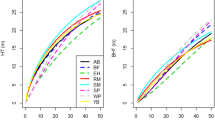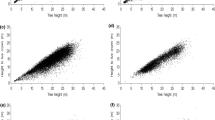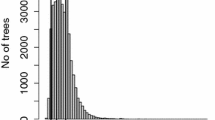Abstract
This work presents the results from the initial model development of a simulator to predict vegetation dynamics in young plantations growing in a Mediterranean environment. The simulator can predict growth dynamics for coniferous crop trees as well as competing hardwoods and shrubs. Model specification included conifer, shrub, and hardwood competition expressed at the plot-level. The system employs water-holding capacity as an indicator of productivity. Growth data were obtained from 109 plantations, ranging in age from 3 to 25, in southern Oregon and northern California. Douglas-fir (Pseudotsuga menziesii Mirb. Franco), the most common conifer species, was observed in 80 of the sampled stands. These observations were used for model development of the primary driving functions, which forecast 2-year basal diameter increment, height increment, and crown width increment. Parameters for all three dynamic expressions for growth were estimated using weighted, nonlinear three-stage least squares. This estimation method provided a predictive model with slight improvements in standard errors for two of the three equations (an average of 3% for height and diameter growth) and no improvement for crown width, when compared with two-stage least squares. The system includes competition from shrubs and hardwoods in predictions of height growth, diameter growth and crown width increment. This allows individual-tree/distance-independent simulator architecture to be extended to young plantations in southern Oregon and northern California.






Similar content being viewed by others
References
Arney, JD, Milner KS, Vopicka CE, Jafvert MA (2004) Forest projection and planning system (FPS) user’s guide and tutorial. Tech Rep 11
Biging GS (1985) Improved estimates of site index curves using a varying-parameter model. For Sci 31:248–259
Borders BE, Bailey RL (1986) A compatible system of growth and yield equations for slash pine fitted with restricted three stage least squares. For Sci 32:185–201
Curtis RO, DeMars DJ, Herman FR (1974) Which dependent variable in site-index-height-age regressions? For Sci 20:74–87
Curtis RO, Diaz NM, Clendenen GW (1990) Height growth and site index curves for western white pine in the Cascade Range of Washington and Oregon. USDA For Serv Res Pap PNW-RP-423
Dolph KL (1991) Site index curves for young-growth California white fir on the western slopes of the Sierra Nevada. USDA For Serv Res Pap PSW-185
Dolph KL (1992) Predicting height increment of young-growth red fir in California and southern Oregon. USDA For Serv Res Pap PSW-RP-214
Flewelling J., Collier R, Gonyea B et al (2001) Height-age curves for planted Douglas-fir, with adjustments for density. SMC Work Pap Num 1, Stand Management Coop., College of Forest Resources, University of Washington
Franklin JF, Dyrness CT (1973) Natural vegetation of Oregon and Washington. USDA For Serv Gen Tech Rep PNW-8
Furnival GM, Wilson RW (1971) Systems of equations for predicting forest growth and yield. In: Patil GP, et al (eds) Statistical ecology, vol 3. Pennsylvania State University Press
Greene WH (2003) Econometric analysis, 5th edn. Prentice Hall, Upper Saddle River
Hann DW (2003) ORGANON User’s manual. Edition 7.0. Dept Forest Resources, Oregon State University
Hann DW, Hanus ML (2002a) Enhanced diameter-growth-rate equations for undamaged and damaged trees in southwest Oregon For Res Lab Res Contrib 39, Oregon State University
Hann DW, Hanus ML (2002b) Enhanced height-growth-rate equations for undamaged and damaged trees in southwest Oregon. For Res Lab Res Contrib 41, Oregon State University
Hann DW, Larsen, DR (1991) Diameter growth equations for fourteen tree species in southwest Oregon. For Res Lab Res Bull 69, Oregon State University
Hann DW, Scrivani JA (1987) Dominant-height-growth and site-index equations for Douglas-fir and ponderosa pine in southwest Oregon. For Res Lab Res Bull 59, Oregon State University
Hanson TJ (1997) Growth of plantation conifers and whiteleaf manzanita in southwest Oregon. Dissertation Oregon State University
Harrington TB, Tappeiner JC (1991) Competition affects shoot morphology, growth duration, and relative growth rates of Douglas-fir saplings. Can J For Res 21:474–481
Hasenauer H, Monserud RA, Gregoire TG (1998) Using simultaneous regression techniques with individual-tree growth models. For Sci 44:87–95
Hausman J (1978) Specification tests in econometrics. Econometrica 46:1251–1271
Huang S, Titus SJ (1999) Estimating a system of nonlinear simultaneous individual tree models for white spruce in boreal mixed-species stands. Can J For Res 29:1805–1811
Knowe SA (1994) Incorporating the effects of interspecific competition and vegetation management treatments in stand table projection models for Douglas-fir saplings. For Ecol Manage 67:87–99
Knowe SA, Harrington TB, Shula RG (1992) Incorporating the effects of interspecific competition and vegetation management treatments in diameter distribution models for Douglas-fir saplings. Can J For Res 22:1255–1262
Maguire DA, Hann DW (1990) A sampling strategy for estimating past crown recession on temporary growth plots. For Sci 36:549–563
McQuilkin RA, Rogers R (1978) A method for determining the precision of site index estimates made from site index prediction functions. For Sci 24:289–296
Monserud RA (1985) Applying height growth and site index curves for inland Douglas-fir. USDA For Serv Res Pap INT-347
Munro DD (1974) Forest growth models—a prognosis. In: Fries J (ed) Growth models for tree and stand simulation. Dept For Yield Res, Royal Coll For Res Note 30
Newton M, Hanson TJ (1998) Bias in site estimation from early competition. In: Proceedings Nineteenth Annual Forest Vegetation Management Conference. Jan. 20–22, 1998. Redding, CA
Powers RF (1972) Estimating site index of ponderosa pine in northern California... standard curves, soil series, stem analysis. USDA For Serv Res Note PSW-265
Powers RF, Oliver WW (1978) Site classification under stocking control in California. USDA For Serv Res Pap PSW-128
Ritchie MW (1999) A compendium of forest growth and yield simulators for the Pacific coast states. USDA For Serv Gen Tech Rep PSW-GTR-174
Ritchie MW, Hamann JD (2006) Modeling dynamics of competing vegetation in young conifer plantations of northern California and southern Oregon, USA. Can J For Res 36:2523–2532
Rose CE, Lynch TB (2001) Estimating parameters for tree basal area growth with a system of equations and seemingly unrelated regressions. For Ecol Manage 148:51–61
SAS Institute, Inc. (1999) SAS/ETS® User’s guide, Version 8. SAS Institute, Inc., Cary
Stage AR (1975) Prediction of height increment for models of forest growth. USDA For Serv Res Pap INT-164
Stage AR (1973) Prognosis model for stand development. USDA For Serv Res Pap INT-137
Stage AR, Wykoff WR (1998) Adapting distance-independent forest growth models to represent spatial variability: Effects of sampling design on model coefficients
Theil H (1953) Repeated least squares applied to complete equation systems. The Hague: Cent. Planning Bureau, Netherlands
Uzoh FCC (2001) A height increment equation for young ponderosa pine plantations using precipitation and soil factors. For Ecol Manage 142:193–203
Wagner RG, Radosevich SR (1991) Neighborhood predictors of interspecific competition in young Douglas-fir plantations. Can J For Res 21:821–828
Walker J, Sharpe PJH, Penridge LK, Wu H (1989) Ecological field theory, the concept and field tests. Vegetatio 83:81–95
Wang ZQ, Newton M, Tappeiner JC (1995) Competitive relations between Douglas-fir and Pacific madrone on shallow soils in a Mediterranean climate. For Sci 41:744–757
Wensel LC, Meeschaert WJ, Biging GS (1987) Tree height and diameter growth models for northern California conifers. Hilgardia 55:1–20
Wensel LC, Daugherty PJ, Meerschaert WJ (1986) CACTOS User’s guide: the California conifer timber output simulator. Bulletin 1920. Div of Ag Sci University of California, Berkeley
White DE (1989) Competitive interactions between Douglas-fir or ponderosa pine and whiteleaf manzanita. Dissertation, Oregon State University
White H (1996) Estimation, inference and specification analysis. Econometric Society Monographs No. 22
Wykoff WR (1990) A basal area increment model for individual conifers in the northern Rocky Mountains. For Sci 36:1077–1104
Wykoff WR, Crookston NL, Stage AR (1982) User’s guide to the Stand Prognosis Model. USDA For Serv Gen Tech Rep INT-133
Zellner A, Theil H (1962) Three stage least squares: simultaneous estimation of simultaneous equations. Econometrica 30:63–68
Acknowledgements
The authors wish to thank Dr. David W. Hann, Dr. Jim Flewelling, Dr. Robert Monserud, and anonymous reviewers who provided helpful comments. Support for data collection was generously provided by the Shasta-Trinity National Forest, Klamath National Forest, Siskiyou National Forest, Rogue River National Forest, southern Oregon Bureau of Land Management, Fruit Growers Supply Company and Roseburg Forest Products.
Author information
Authors and Affiliations
Corresponding author
Rights and permissions
About this article
Cite this article
Ritchie, M.W., Hamann, J.D. Individual-tree height-, diameter- and crown-width increment equations for young Douglas-fir plantations. New Forests 35, 173–186 (2008). https://doi.org/10.1007/s11056-007-9070-7
Received:
Accepted:
Published:
Issue Date:
DOI: https://doi.org/10.1007/s11056-007-9070-7




